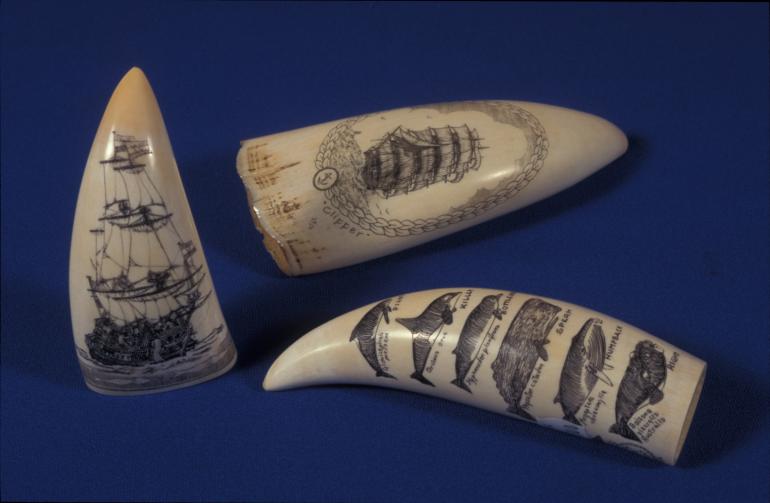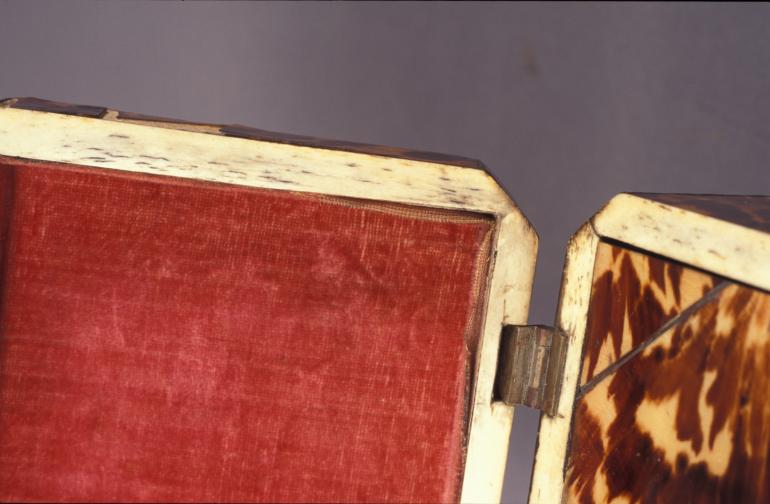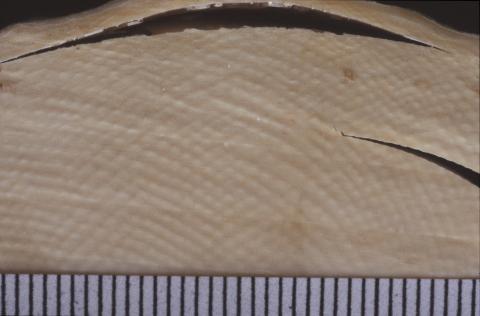Ivory, Bone and Related Materials
I. M. Godfrey
Introduction
The use of bone and ivory dates back to prehistoric times. Early people, hunting animals for food and clothing, would use as much of the beast as possible with the teeth (ivory) and bones used for arrowheads, handles and other implements. Over time this usage extended to weaponry, musical instruments, religious pieces, personal artefacts, decorative items, artistic pieces and items for games (Figure 1).
Figure 1: Examples of scrimshaw on sperm whale teeth.
When people speak of ivory, it is generally assumed that the material is from the large incisor teeth or tusks of either the African or Indian elephant. The teeth of numerous other animals including the hippopotamus, sperm whale, narwhal, walrus, wart hog and wild boar have also been used for some of the purposes mentioned above. Fossil ivories of the mastodon and the mammoth have been carved. An expert is able to distinguish between ivory types by examining differences in grain, colour, texture and hardness. Due to physical and chemical changes that occur in burial environments however, the identification of archaeological ivory can be very difficult, if not impossible, depending on the ivory type and the size and shape of the object.
As the structure of bone is more open than that of ivory, it is more easily stained and coloured. Bone can be difficult to differentiate from ivory when worked and polished with oils and waxes. Horn, baleen and tortoise shell are all skin-based materials that have been used for similar purposes to bone and ivory (Figure 2). The Tagua nut, derived from certain palm trees native to South America, Micronesia and Africa, also resembles ivory, stains easily and can be carved in the same way as authentic ivory. It is white with a marbled appearance and has been used for buttons, jewellery and artistic carvings.
Figure 2: Close-up of box made from tortoise shell overlaid onto bone.
In 1862 at the Great International Exhibitions in London, Alexander Parkes exhibited a material called ‘Parkesine’, a modified cellulose nitrate plastic. This material was substituted for ivory in billiard balls and laid the foundations for the plastics industry. Known as French ivory and, along with other materials such as mixtures of ivory and bone dust mixed with chalk, gelatin, gutta-percha and plaster of Paris, cellulose nitrate formed the basis of an extensive industry in synthetic substitutes for natural materials.
Today pigmented polyester resins are used to imitate these earlier works of art. Normally a silicone mould is made of the original and then pigmented resin is poured in. Once set, the surface can be treated with paint or dye to highlight any surface details. The opaque nature and uniform colour of these copies are usually sufficient to identify them.
Nature and Composition
Bone-like materials (ivory, bone and antler) are made up of both organic and inorganic components. The major organic component is the fibrous protein collagen. This makes up about 25 - 30 % of these natural substances with most of the balance being made up of inorganic calcium phosphate containing small amounts of magnesium and carbonate. Even when dry these mineralised tissues contain up to 10 % water. Skin derivatives such as horn, baleen and tortoise shell have the sulphur-containing protein keratin as the main constituent.
Vegetable, or palm ivory is composed of almost pure cellulose, the fundamental constituent of the cell walls of plants while synthetic ivory substitutes can be prepared from a variety of different materials (see above).
Identification
Although it is often difficult to differentiate between bone, ivory, horn and synthetic substitutes, an examination of the morphological, surface and structural features or of the chemical composition of a material usually allows a positive identification to be made. A high quality hand lens and examination of photographs or photomicrographs which highlight structural features makes it easier to identify these materials (Penniman 1952). Antler and bone, although difficult to distinguish from each other in a worked piece, can be distinguished from ivory with a hand lens. This is because the ivory contains none of the microscopic pores that, in life, contained the blood vessels that fed the growing bone or antler.
Morphological features such as the shape and size of the materials in their unworked state, together with elements such as the marrow cavity in long bones and the pulp cavity in tusks may aid the identification process.
Ivory is basically another form of bone called dentine. Despite their different structures bone and ivory have similar chemical compositions. Thus, unless some material is available for destructive analysis, chemical tests cannot usually distinguish between bone and ivory.
Features which may identify elephant ivory include:
- the pattern of intersecting arcs, usually referred to as ‘engine turning’ or Schreger lines, which are found on the cross-sectional (transverse) surface. These are quite clearly visible on African elephant ivory (Figure 3) but are slightly more difficult to observe on Indian elephant ivory;
- the presence of slightly wavy or braided continuous lines on the longitudinal surfaces;
- the presence of ‘cloudy’ areas, which are sometimes wavy, on longitudinal surfaces. These ‘clouds’ appear as areas which are whiter and more opaque than the material between them.
A further characteristic of all ivories is their fluorescence with a bluish light when irradiated with long wave ultra-violet (UV) light. Depending on the ivory type, this fluorescence varies from bluish-white to a deep violet blue (Penniman 1952). The difference in fluorescence from old ivories also may be useful in distinguishing old from new surfaces, as an aged patina fluoresces in mottled yellow tones while newer ivories and restorations usually appear deep blue-purple. Synthetic materials often exhibit a brilliant fluorescence, quite different from the natural substances.
Figure 3: Elephant ivory showing intersecting arcs (Schreger lines) which help to identify this material.
Identifying features of bone include the following:
- generally lighter in weight than a similar sized piece of ivory;
- the presence of a porous cavity often visible on the back surface of an artefact;
- the presence of small pits that held the blood vessels and short longitudinal striations. These often appear as very small dots and darkened lines on the longitudinal surfaces, features which are enhanced by dirt which collects in them.
Microscopic examination, including the use of polarised light, or an examination of materials under UV light may allow materials such as horn, baleen, tortoise shell and vegetable ivory to be identified. Vegetable ivory is characterised by the presence of very fine, slightly darker concentric lines on the transverse surface and by numerous star-shaped pits throughout the tissue.
Vegetable ivory and man-made alternatives to the natural bone-like materials can be differentiated easily by spectroscopic or chemical methods. Infra-red (IR) spectroscopy in particular, allows for rapid and usually unambiguous identification of polymeric substances (ivory copies). This type of analysis must be carried out by an expert. Although IR analyses are usually destructive, only a small amount of material (less than one milligram) is required for testing. Careful analysis of IR spectra can also provide valuable information about the degree of degradation of bone and ivory, providing valuable information about changes in the amounts and compositions of the organic and inorganic components (Godfrey et al 2002).
A very simple, though destructive, method of determining whether a material is composed of a synthetic substance is the ‘hot needle’ test. Many of the polymeric materials used as substitutes for bone and ivory will melt when heated. A hot needle applied to an inconspicuous part of an object should give a quick, though not reliable estimate, of the composition of the object in question. Because of the destructive nature of this test, however, it is not recommended.
For full descriptions of the methods available to differentiate ivory, bone and related materials refer to Penniman (1952), Thornton (1981), Krzyszkowska (1990), Locke (2013) and Mann (2013).















